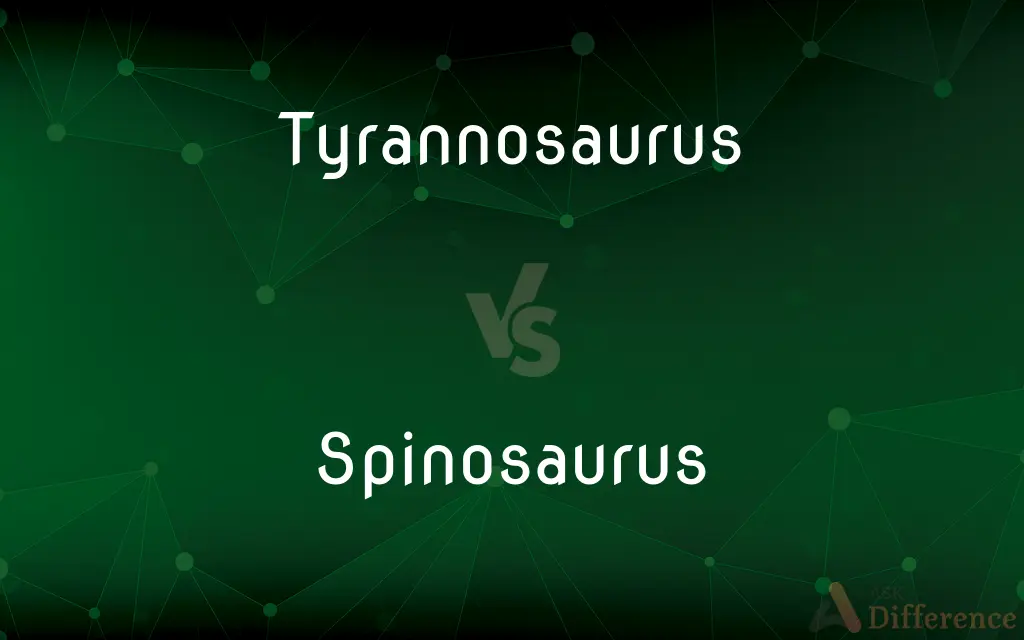Tyrannosaurus vs. Spinosaurus — What's the Difference?
Edited by Tayyaba Rehman — By Maham Liaqat — Updated on March 21, 2024
Tyrannosaurus, a large theropod known for its massive skull and bipedal stance, contrasts with Spinosaurus, distinguished by its sail-like spine and semi-aquatic lifestyle.

Difference Between Tyrannosaurus and Spinosaurus
Table of Contents
ADVERTISEMENT
Key Differences
The Tyrannosaurus, often abbreviated as T. rex, is one of the most iconic dinosaurs, renowned for its formidable size, with estimates suggesting it reached lengths of up to 40 feet and weighed as much as 9 tons. It lived approximately 68 to 66 million years ago during the late Cretaceous period. On the other hand, the Spinosaurus, which lived during the Cretaceous period about 112 to 97 million years ago, is notable for its unique physical adaptations, including a long, narrow skull similar to that of modern crocodilians, and a distinctive sail-like structure on its back formed by elongated spines. Estimates of its size suggest it could reach lengths of over 50 feet, making it one of the largest known carnivorous dinosaurs.
Tyrannosaurus is characterized by its massive skull, powerful jaw with sharp teeth, and bipedal locomotion, indicating a primarily terrestrial lifestyle where it likely played the role of apex predator. Unlike the Tyrannosaurus, evidence points towards a semi-aquatic lifestyle for the Spinosaurus, with adaptations suggesting it fed on fish and other aquatic prey.
While the Tyrannosaurus roamed the landscapes of what is now North America, the Spinosaurus was native to the swamps and rivers of Northern Africa. This geographical distinction reflects the diverse ecosystems that existed during the Cretaceous period and the evolutionary adaptations of each species to their respective environments. The diet of the Tyrannosaurus likely included large dinosaurs like Triceratops and Edmontosaurus, showcasing its role as a dominant terrestrial predator. Conversely, the Spinosaurus, with its crocodile-like jaws and conical teeth, was well-adapted to catching fish, indicating a dietary preference that aligned with its semi-aquatic habitat.
Another notable difference between these two dinosaurs is their locomotion. The Tyrannosaurus, with its powerful hind legs and robust tail, was adapted for bipedal movement, allowing it to traverse land swiftly in pursuit of prey or to defend its territory. In contrast, the Spinosaurus's physical adaptations, including possible webbed feet and a paddle-like tail, suggest it was adept at moving through water, further supporting the hypothesis of its semi-aquatic lifestyle. This distinction in locomotion reflects the evolutionary divergence between the two species, with each adapting to thrive in very different environments.
In terms of scientific interest and public fascination, both dinosaurs have captivated imaginations worldwide, though the Tyrannosaurus perhaps edges out in popularity due to its frequent portrayal in media and literature as the quintessential predator dinosaur. However, the discovery and ongoing research into the Spinosaurus have highlighted the incredible diversity of dinosaur life and the complexity of their ecosystems, challenging previously held notions about dinosaur behavior and ecology.
ADVERTISEMENT
Comparison Chart
Period
Late Cretaceous (68-66 million years ago)
Cretaceous (112-97 million years ago)
Size
Up to 40 feet in length and 9 tons in weight
Over 50 feet in length, making it one of the largest carnivores
Habitat
Terrestrial environments of North America
Semi-aquatic habitats in Northern Africa
Distinct Features
Massive skull, powerful jaws with sharp teeth, bipedal stance
Long, narrow skull, sail-like spine, possibly webbed feet
Diet
Large dinosaurs (e.g., Triceratops)
Primarily fish and aquatic creatures
Locomotion
Bipedal, adapted for running
Adapted for swimming and walking in shallow water
Role in Ecosystem
Apex predator
Predatory, but with a significant focus on aquatic prey
Compare with Definitions
Tyrannosaurus
A genus of large theropod dinosaur.
The Tyrannosaurus was one of the last standing dinosaurs before the mass extinction.
Spinosaurus
A genus of large theropod dinosaur with a distinctive sail.
The Spinosaurus is easily recognizable by its sail-like spine.
Tyrannosaurus
Known for its size and predatory nature.
The powerful jaws of the Tyrannosaurus made it a fearsome predator.
Spinosaurus
Semi-aquatic lifestyle.
Unlike many other dinosaurs, the Spinosaurus spent much of its time in water.
Tyrannosaurus
Iconic in popular culture.
Tyrannosaurus frequently appears in dinosaur movies and books.
Spinosaurus
Adapted to hunting aquatic prey.
The Spinosaurus's conical teeth were perfect for catching fish.
Tyrannosaurus
Lived in the Late Cretaceous period.
The Tyrannosaurus roamed the earth around 68 to 66 million years ago.
Spinosaurus
One of the largest carnivorous dinosaurs.
The Spinosaurus may have been the largest carnivorous dinosaur, even larger than Tyrannosaurus.
Tyrannosaurus
Bipedal locomotion.
Tyrannosaurus walked on two legs, using its tail for balance.
Spinosaurus
Lived during the Cretaceous period.
Spinosaurus existed around 112 to 97 million years ago in what is now Northern Africa.
Tyrannosaurus
Tyrannosaurus is a genus of tyrannosaurid theropod dinosaur. The species Tyrannosaurus rex (rex meaning "king" in Latin), often called T. rex or colloquially T-Rex, is one of the best represented of these large theropods.
Spinosaurus
Spinosaurus (meaning "spine lizard") is a genus of spinosaurid dinosaur that lived in what now is North Africa during the Cenomanian to upper Turonian stages of the Late Cretaceous period, about 99 to 93.5 million years ago. This genus was known first from Egyptian remains discovered in 1912 and described by German palaeontologist Ernst Stromer in 1915.
Tyrannosaurus
Any of various tyrannosaurid dinosaurs of the genus Tyrannosaurus, having a large head and teeth and short forelimbs, and including T. rex and possibly some other species. Also called tyrannosaur.
Spinosaurus
A very large carnivorous theropod dinosaur of the genus Spinosaurus of the Cretaceous Period, characterized by a long narrow snout and long spines on the back that may have formed a sail-like structure.
Tyrannosaurus
See T. rex.
Spinosaurus
A large, extinct, carnivorous dinosaur of genus Spinosaurus, with a long snout like that of a crocodile and with a sail on its back. It is considered to be the largest Theropod dinosaur.
Tyrannosaurus
A large carnivorous dinosaur, of the genus Tyrannosaurus, found in North America during the late Cretaceous period.
Tyrannosaurus
Large carnivorous bipedal dinosaur having enormous teeth with knifelike serrations; may have been a scavenger rather than an active predator; later Cretaceous period in North America
Common Curiosities
Which was larger, Tyrannosaurus or Spinosaurus?
Spinosaurus is estimated to have been larger than Tyrannosaurus, potentially the largest carnivorous dinosaur known.
Did Tyrannosaurus and Spinosaurus live at the same time?
No, they lived during different times within the Cretaceous period, with Tyrannosaurus appearing later.
What made Spinosaurus's sail distinctive?
The sail was likely used for display, thermoregulation, or storing fat, though its exact purpose remains debated among scientists.
What was the primary diet of Tyrannosaurus?
Tyrannosaurus likely fed on large dinosaurs, utilizing its powerful jaws and sharp teeth to hunt or scavenge.
Why is Tyrannosaurus more popular than Spinosaurus?
Its frequent portrayal in media as the ultimate predator has made Tyrannosaurus more iconic, though interest in Spinosaurus has grown with recent discoveries.
Could Tyrannosaurus swim?
There is no direct evidence that Tyrannosaurus was adapted for swimming, unlike the semi-aquatic Spinosaurus.
Were Tyrannosaurus and Spinosaurus apex predators in their respective habitats?
Yes, both were likely apex predators, though Spinosaurus's diet was more specialized towards aquatic prey.
How did the environments of Tyrannosaurus and Spinosaurus differ?
Tyrannosaurus inhabited terrestrial environments with diverse ecosystems, including forests and plains, in what is now North America. In contrast, Spinosaurus lived in the semi-aquatic and riverine environments of Northern Africa, indicating a significant ecological difference between the two.
What adaptations did Spinosaurus have for its semi-aquatic lifestyle?
Spinosaurus exhibited several adaptations for a semi-aquatic life, including a long, crocodile-like skull for catching fish, conical teeth for gripping slippery prey, possibly webbed feet for swimming, and a paddle-like tail that recent discoveries suggest was used for propulsion in water.
How do we know Spinosaurus was semi-aquatic?
Fossil evidence, including isotopic analyses and physical adaptations like its skull shape and possible webbed feet, suggests a semi-aquatic lifestyle.
What impact did the physical size of Tyrannosaurus and Spinosaurus have on their ecosystems?
The massive size of both Tyrannosaurus and Spinosaurus would have positioned them as apex predators, capable of preying on large animals and influencing the population dynamics of other species in their ecosystems. Their size also suggests they had few natural predators.
What ongoing research or recent discoveries have been made about Tyrannosaurus and Spinosaurus?
Ongoing research includes studies on Spinosaurus's tail structure and its implications for aquatic locomotion, and new Tyrannosaurus specimens that may provide insights into their growth patterns, social behavior, and ecological impact. Paleontologists continue to unearth new fossils that challenge and refine our understanding of these prehistoric giants.
How do scientists study and understand the behavior of Tyrannosaurus and Spinosaurus?
Scientists study these dinosaurs through fossil evidence, including bones, teeth, and in some cases, trace fossils such as footprints. Advanced technologies like CT scanning and isotopic analysis also provide insights into their diet, locomotion, and environmental adaptations. Comparative anatomy with modern animals helps infer their behavior and ecology.
Share Your Discovery

Previous Comparison
Bubble vs. Void
Next Comparison
Pyrophile vs. PygophileAuthor Spotlight
Written by
Maham LiaqatEdited by
Tayyaba RehmanTayyaba Rehman is a distinguished writer, currently serving as a primary contributor to askdifference.com. As a researcher in semantics and etymology, Tayyaba's passion for the complexity of languages and their distinctions has found a perfect home on the platform. Tayyaba delves into the intricacies of language, distinguishing between commonly confused words and phrases, thereby providing clarity for readers worldwide.















































